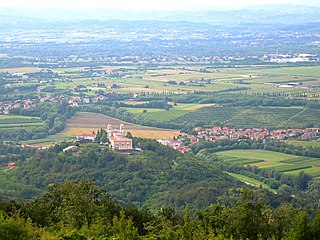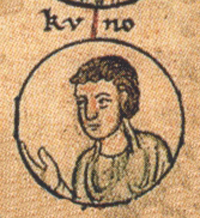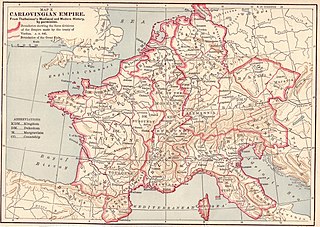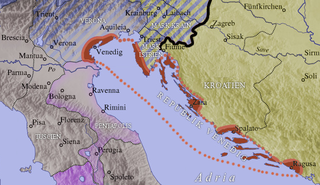Geography
The march roughly comprised the historic Friuli and Veneto regions from the border with Lombardy and the Chiese River in the west to the Tagliamento and the Isonzo (Soča) in the east, the upper Soča valley within the Julian Alps is today part of the Slovenian Goriška region. Initially it also included present-day Trentino uphill to the Adige river in the northwest. Except for the lagoons controlled by Venice, it stretched from the Adriatic Sea to the crest of the Dolomites and the Carnic Alps in the north, where the mountainous Carnia region borders with Carinthia. The western lands around Verona comprised the Po Valley, the Euganean and Berici Hills, the Venetian Prealps and Lake Garda.
Beside the capital Verona near the southwestern border with Tuscany, the march included the episcopal seat of Aquileia, the historic Friulian capital Udine with nearby Cividale and the port of Grado in the east, as well as the major cities of Vicenza, Treviso, and Padua, which played a vital role in forming the Lombard League. The March of Verona was a strategically important province, which governed the southern approaches to the Alpine passes leading to Germany, and significant in the—ultimately failed—attempts of the Holy Roman Emperors to maintain the rule over Italy.
History
The Marca Veronensis et Aquileiensis was created by King Berengar I of Friuli about 890 as part of a general restructuring of his realm, when it replaced the former Carolingian March of Friuli last held by Berengar's liensman Walfred. It was separated from the Italian kingdom after the German king Otto I had campaigned against King Berengar II of Italy in 951. At the Reichstag meeting at Augsburg in the next year, Berengar II retained Italy, but had to renounce the Veronese march, which was attached to the stem duchy of Bavaria under Otto's brother Duke Henry I. At that time the March of Istria was attached to Verona as a county. From 952 to 975, both Carinthia and Verona were under the control of the dukes of Bavaria, forming a massive Italian, German, and Slavic fief ruled by relatives of the Saxon Ottonian dynasty. [1]
After several revolts led by his Bavarian cousins, Emperor Otto II in 976 deposed Duke Henry II of Bavaria and established the Duchy of Carinthia under the loyal Luitpolding vassal Henry the Younger on the southeastern territories. He also received Verona as a Carinthian march and from that time on, it was under the control of the Carinthian dukes and at other times not. Already in 975, a commune had been chartered in the capital city, when Otto II ceded to Verona the powers of the marquisate. From this time Verona and several other cities in the march gradually developed into independent city-states, and in turn the title Margrave of Verona became an essentially empty hereditary honour in the ducal houses of Bavaria and Carinthia. Henceforth the Holy Roman Emperors began to appoint vicars to represent them, instead of margraves, in Verona.
From 1004 King Henry II of Germany, having conquered the Kingdom of Italy, allotted several Veronese territories in the Adige Valley around Trento (Trient) to the Bishops of Trent. His Salian successor, Emperor Conrad II, upon his coronation in 1027 separated these lands from the Italian kingdom and gave the Trent bishops immediate authority, elevating them to the rank of Imperial Prince-Bishops. Trentino remained under episcopal rule—contested by the Counts of Tyrol—until its secularisation in 1803.
In 1061 Empress Agnes enfeoffed the Swabian count Berthold from the House of Zähringen with Carinthia and Verona. Though he could not prevail, neither as Carinthian duke nor as Veronese margrave, he bequested the title to his descendants from the House of Baden, who went on to rule their Swabian territories as a "Margraviate". At that time in 1070, Istria was resurrected into a march again and detached from Verona, while in the course of the Investiture Controversy in 1077 the territories of Friuli in the east, around the episcopal city of Aquileia were separated from the March to provide an ecclesiastical Patriarchate of Aquileia, like Trent an immediate vassal of King Henry IV of Germany.
In 1151 the Hohenstaufen King Conrad III of Germany finally divested Duke Henry V of Carinthia of the remaining Veronese march and enfeoffed Margrave Herman III of Baden. However, in 1164, the most important cities formed the Veronese League, a Städtebund association aimed at protecting their independence against the Italian policies of Conrad's nephew Emperor Frederick Barbarossa. The League was led by Venice; other members were Verona, Padua, Vicenza, and Treviso. In 1167, the Veronese cities joined the Lombard League; this constituted the de facto end of the march, confirmed by the Lombard victory at the 1176 Battle of Legnano. The Emperors continued to name vicars, though by then the office was purely nominal, as from the 13th century onwards the actual lords of Verona were the podestàs from the Scaliger (della Scala) dynasty. In 1405 the Veronese citizens submitted to Venice, which until about 1420 conquered most of the territory of the former march and incorporated it into the Domini di Terraferma .

The Duchy of Carinthia was a duchy located in southern Austria and parts of northern Slovenia. It was separated from the Duchy of Bavaria in 976, and was the first newly created Imperial State after the original German stem duchies.

The Duchy of Bavaria was a frontier region in the southeastern part of the Merovingian kingdom from the sixth through the eighth century. It was settled by Bavarian tribes and ruled by dukes (duces) under Frankish overlordship. A new duchy was created from this area during the decline of the Carolingian Empire in the late ninth century. It became one of the stem duchies of the East Frankish realm which evolved as the Kingdom of Germany and the Holy Roman Empire.

Berengar II was the King of Italy from 950 until his deposition in 961. He was a scion of the Anscarid and Unruoching dynasties, and was named after his maternal grandfather, Berengar I. He succeeded his father as Margrave of Ivrea around 923, and after 940 led the aristocratic opposition to kings Hugh and Lothair II. In 950 he succeeded the latter and had his son, Adalbert crowned as his co-ruler. In 952 he recognised the suzerainty of Otto I of Germany, but he later joined a revolt against him. In 960 he invaded the Papal States, and the next year his kingdom was conquered by Otto. Berengar remained at large until his surrender in 964. He died imprisoned in Germany two years later.

Arduin was an Italian nobleman who was King of Italy from 1002 until 1014.

Goriška is a historical region in western Slovenia on the border with Italy. It comprises the northern part of the wider traditional region of the Slovenian Littoral (Primorska). The name Goriška is an adjective referring to the city of Gorizia, its historical and cultural centre.
Henry of Eppenstein was Duke of Carinthia and Margrave of Verona from 1090 to 1122. He was the last duke from the House of Eppenstein.
Berthold II, Duke of Carinthia, also known as Berthold I of Zähringen, was a progenitor of the Swabian House of Zähringen. From 1061 until 1077, he was the Duke of Carinthia and Margrave of Verona.
Adalbero of Eppenstein was Duke of Carinthia and Margrave of Verona from 1011 or 1012 until 1035.

Conrad I, a member of the Salian dynasty, was Duke of Carinthia from 1004 until his death.

The Marchof Carniola was a southeastern state of the Holy Roman Empire in the High Middle Ages, the predecessor of the Duchy of Carniola. It corresponded roughly to the central Carniolan region of present-day Slovenia. At the time of its creation, the march served as a frontier defense against the Kingdoms of Hungary and Croatia.

The March of Friuli was a Carolingian frontier march, established in 776 as the continuation of the Lombard Duchy of Friuli, established against the Slavs and Avars. It was ceded to the Duchy of Bavaria as the March of Verona in 952. Its territory comprised parts of modern-day Italy, Slovenia and Croatia.

The March of Istria was originally a Carolingian frontier march covering the Istrian peninsula and surrounding territory conquered by Charlemagne's son Pepin of Italy in 789. After 1364, it was the Istrian province of the Habsburg monarchy, the Austrian Empire and Austria-Hungary.
Poppo I, Count of Weimar-Orlamünde, was margrave of Istria from 1012 and of Carniola from 1040 to his death.
The House of Sponheim or Spanheim was a medieval German noble family, which originated in Rhenish Franconia. They were immediate Counts of Sponheim until 1437 and Dukes of Carinthia from 1122 until 1269. Its cadet branches ruled in the Imperial County of Ortenburg-Neuortenburg and various Sayn-Wittgenstein states until 1806.
Engelbert III, a member of the Rhenish Franconian House of Sponheim, was Margrave of Istria from 1124 until his death.

The March of Carinthia was a frontier district (march) of the Carolingian Empire created in 889. Before it was a march, it had been a principality or duchy ruled by native-born Slavic princes at first independently and then under Bavarian and subsequently Frankish suzerainty. The realm was divided into counties which, after the succession of the Carinthian duke to the East Frankish throne, were united in the hands of a single authority. When the march of Carinthia was raised into a Duchy in 976, a new Carinthian march was created. It became the later March of Styria.

The House of Andechs was a feudal line of German princes in the 12th and 13th centuries. The counts of Dießen-Andechs obtained territories in northern Dalmatia on the Adriatic seacoast, where they became Margraves of Istria and ultimately dukes of a short-lived imperial state named Merania from 1180 to 1248. They were also self-styled lords of Carniola.

The Patria del Friuli was the territory under the temporal rule of the Patriarch of Aquileia and one of the ecclesiastical states of the Holy Roman Empire. In 1420, the Republic of Venice acquired it, but it continued to be ruled for some time under its own laws and customs.
Liutold of Eppenstein was Duke of Carinthia and Margrave of Verona from 1077 until his death.
This page is based on this
Wikipedia article Text is available under the
CC BY-SA 4.0 license; additional terms may apply.
Images, videos and audio are available under their respective licenses.















